RSK4 Recombinant Rabbit Monoclonal Antibody [PSH02-04]

cat.: HA721763
| Product Type: | Recombinant Rabbit monoclonal IgG, primary antibodies |
|---|---|
| Species reactivity: | Human, Mouse, Rat |
| Applications: | WB, IHC-P, IF-Cell, FC |
| Clonality: | Monoclonal |
| Clone number: | PSH02-04 |
| Form: | Liquid |
| Storage condition: | Shipped at 4℃. Store at +4℃ short term (1-2 weeks). It is recommended to aliquot into single-use upon delivery. Store at -20℃ long term. |
| Storage buffer: | PBS (pH7.4), 0.1% BSA, 40% Glycerol. Preservative: 0.05% Sodium Azide. |
| Concentration: | 1ug/ul |
| Purification: | Protein A affinity purified. |
| Molecular weight: | Predicted band size: 84 kDa |
| Isotype: | IgG |
| Immunogen: | Recombinant protein within human RSK4 aa 31-420 / 745. |
| Positive control: | HEK-293 cell lysate, Caco-2 cell lysate, MDA-MB-231 cell lysate, MDA-MB-468 cell lysate, Raji cell lysate, Ramos cell lysate, NIH/3T3 cell lysate, PC-12 cell lysate, human kidney tissue, mouse kidney tissue, rat kidney tissue, PC-12, Caco-2. |
| Subcellular location: | Cytoplasm, cytosol, Nucleus. |
| Recommended Dilutions:
WB IHC-P IF-Cell FC |
1:1,000 1:200-1:1,000 1:100 1:1,000 |
| Uniprot #: | SwissProt: Q9UK32 Human | Q7TPS0 Mouse Entrez Gene: 317203 Rat |
| Alternative names: | 90 kDa ribosomal protein S6 kinase 6 KS6A6_HUMAN p90 RSK 6 p90-RSK 6 p90RSK6 pp90RSK4 Ribosomal protein S6 kinase 90kDa polypeptide 6 Ribosomal protein S6 kinase alpha 6 Ribosomal protein S6 kinase alpha-6 Ribosomal S6 kinase 4 rps6ka6 RSK 4 RSK-4 S6K-alpha-6 |
Images
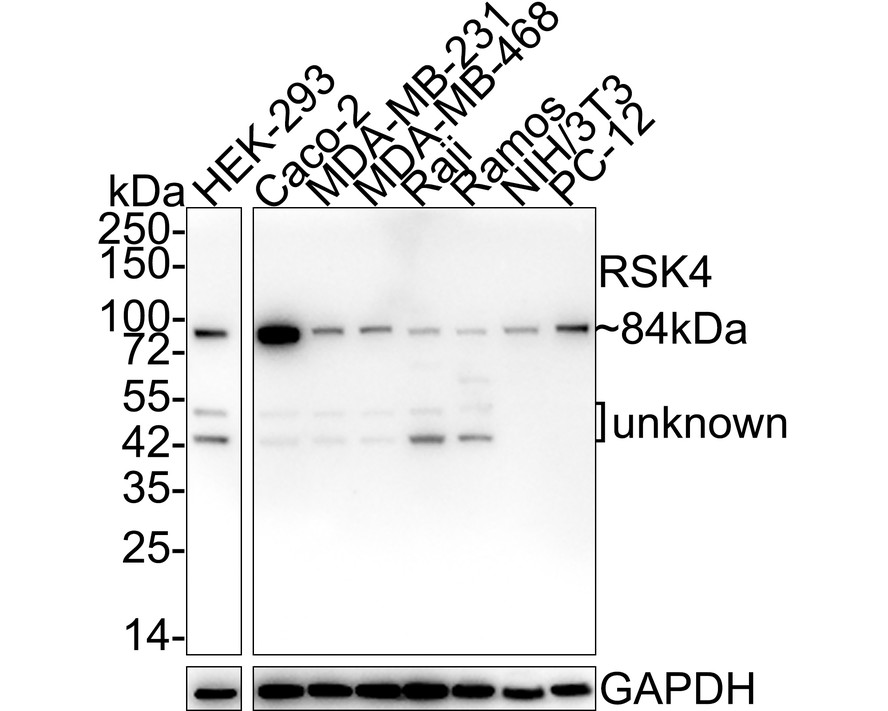
|
Fig1:
Western blot analysis of RSK4 on different lysates with Rabbit anti-RSK4 antibody (HA721763) at 1/1,000 dilution. Lane 1: HEK-293 cell lysate Lane 2: Caco-2 cell lysate Lane 3: MDA-MB-231 cell lysate Lane 4: MDA-MB-468 cell lysate Lane 5: Raji cell lysate Lane 6: Ramos cell lysate Lane 7: NIH/3T3 cell lysate Lane 8: PC-12 cell lysate Lysates/proteins at 20 µg/Lane. Predicted band size: 84 kDa Observed band size: 84 kDa Exposure time: 1 minute 14 seconds; 4-20% SDS-PAGE gel. Proteins were transferred to a PVDF membrane and blocked with 5% NFDM/TBST for 1 hour at room temperature. The primary antibody (HA721763) at 1/1,000 dilution was used in 5% NFDM/TBST at room temperature for 2 hours. Goat Anti-Rabbit IgG - HRP Secondary Antibody (HA1001) at 1/50,000 dilution was used for 1 hour at room temperature. |
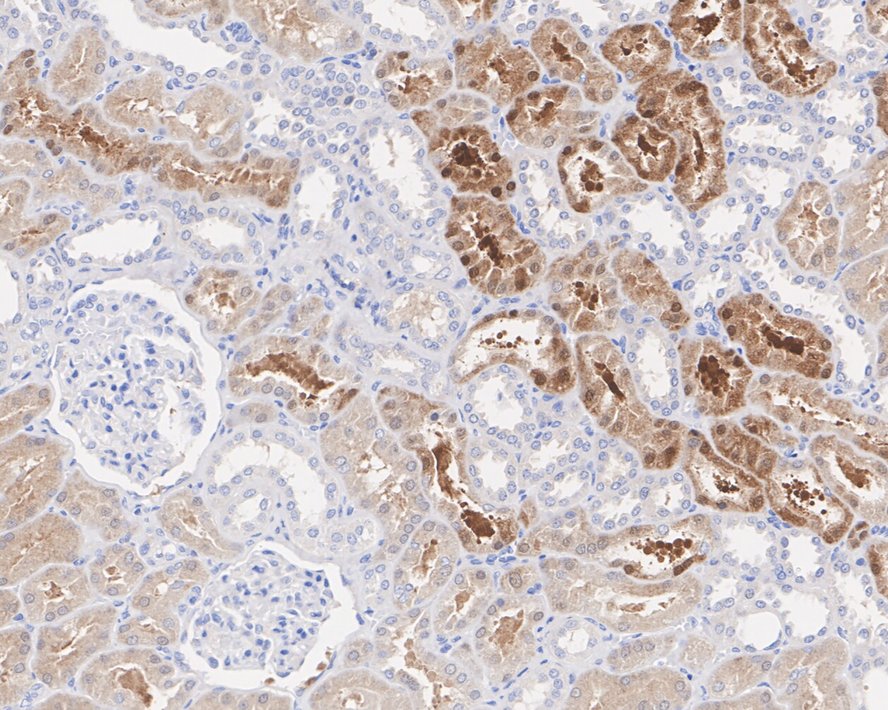
|
Fig2:
Immunohistochemical analysis of paraffin-embedded human kidney tissue with Rabbit anti-RSK4 antibody (HA721763) at 1/200 dilution. The section was pre-treated using heat mediated antigen retrieval with sodium citrate buffer (pH 6.0) for 2 minutes. The tissues were blocked in 1% BSA for 20 minutes at room temperature, washed with ddH2O and PBS, and then probed with the primary antibody (HA721763) at 1/200 dilution for 1 hour at room temperature. The detection was performed using an HRP conjugated compact polymer system. DAB was used as the chromogen. Tissues were counterstained with hematoxylin and mounted with DPX. |
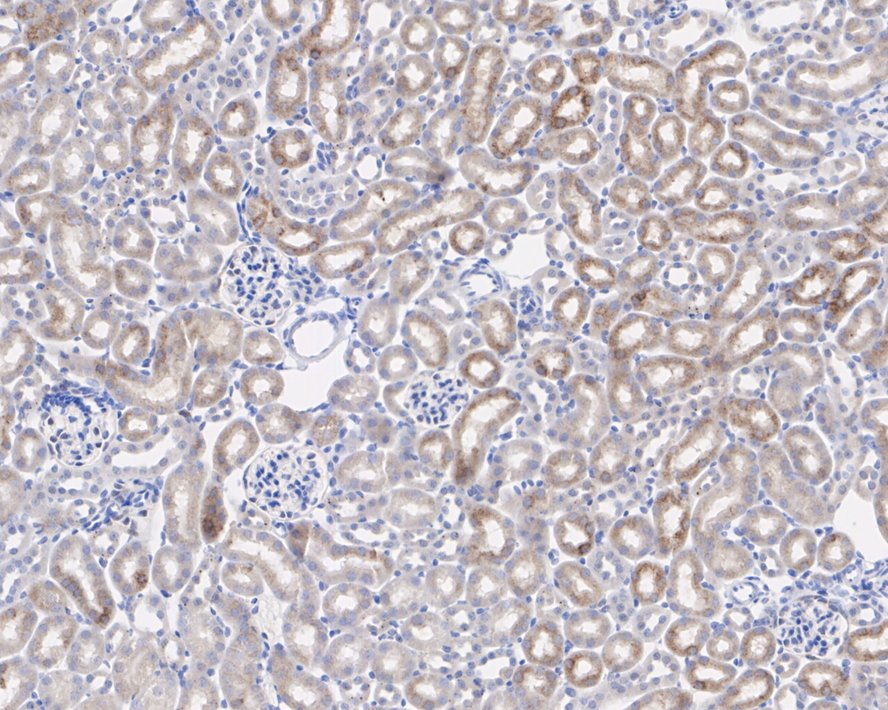
|
Fig3:
Immunohistochemical analysis of paraffin-embedded mouse kidney tissue with Rabbit anti-RSK4 antibody (HA721763) at 1/1,000 dilution. The section was pre-treated using heat mediated antigen retrieval with sodium citrate buffer (pH 6.0) for 2 minutes. The tissues were blocked in 1% BSA for 20 minutes at room temperature, washed with ddH2O and PBS, and then probed with the primary antibody (HA721763) at 1/1,000 dilution for 1 hour at room temperature. The detection was performed using an HRP conjugated compact polymer system. DAB was used as the chromogen. Tissues were counterstained with hematoxylin and mounted with DPX. |
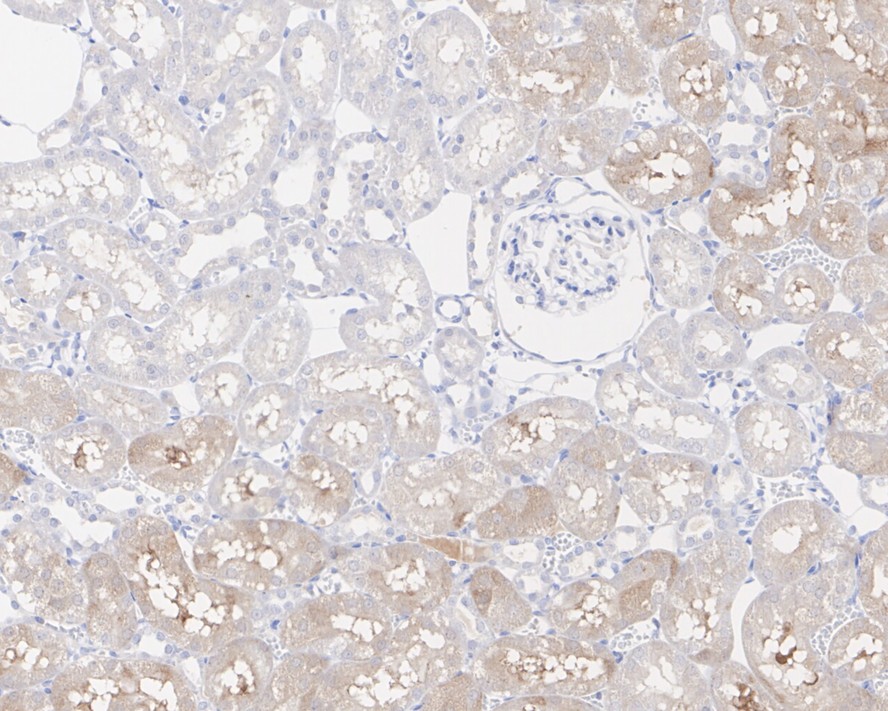
|
Fig4:
Immunohistochemical analysis of paraffin-embedded rat kidney tissue with Rabbit anti-RSK4 antibody (HA721763) at 1/1,000 dilution. The section was pre-treated using heat mediated antigen retrieval with sodium citrate buffer (pH 6.0) for 2 minutes. The tissues were blocked in 1% BSA for 20 minutes at room temperature, washed with ddH2O and PBS, and then probed with the primary antibody (HA721763) at 1/1,000 dilution for 1 hour at room temperature. The detection was performed using an HRP conjugated compact polymer system. DAB was used as the chromogen. Tissues were counterstained with hematoxylin and mounted with DPX. |

|
Fig5:
Immunocytochemistry analysis of PC-12 cells labeling RSK4 with Rabbit anti-RSK4 antibody (HA721763) at 1/100 dilution. Cells were fixed in 4% paraformaldehyde for 20 minutes at room temperature, permeabilized with 0.1% Triton X-100 in PBS for 5 minutes at room temperature, then blocked with 1% BSA in 10% negative goat serum for 1 hour at room temperature. Cells were then incubated with Rabbit anti-RSK4 antibody (HA721763) at 1/100 dilution in 1% BSA in PBST overnight at 4 ℃. Goat Anti-Rabbit IgG H&L (iFluor™ 488, HA1121) was used as the secondary antibody at 1/1,000 dilution. PBS instead of the primary antibody was used as the secondary antibody only control. Nuclear DNA was labelled in blue with DAPI. Beta tubulin (M1305-2, red) was stained at 1/100 dilution overnight at +4℃. Goat Anti-Mouse IgG H&L (iFluor™ 594, HA1126) was used as the secondary antibody at 1/1,000 dilution. |
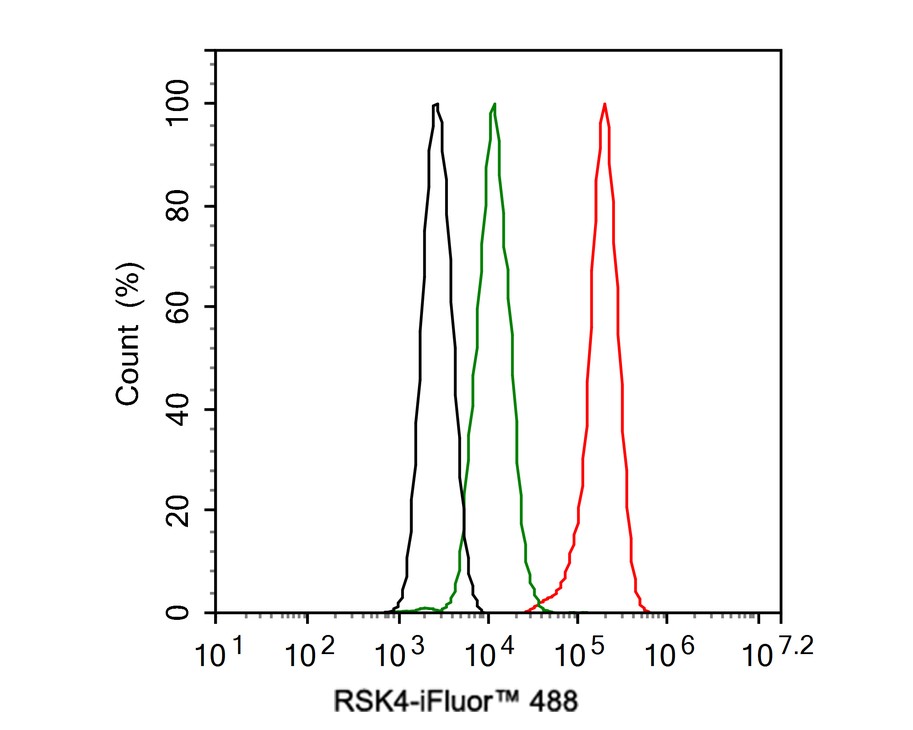
|
Fig6:
Flow cytometric analysis of Caco-2 cells labeling RSK4. Cells were fixed and permeabilized. Then stained with the primary antibody (HA721763, 1μg/mL) (red) compared with Rabbit IgG Isotype Control (green). After incubation of the primary antibody at +4℃ for an hour, the cells were stained with a iFluor™ 488 conjugate-Goat anti-Rabbit IgG Secondary antibody (HA1121) at 1/1,000 dilution for 30 minutes at +4℃. Unlabelled sample was used as a control (cells without incubation with primary antibody; black). |
Note: All products are “FOR RESEARCH USE ONLY AND ARE NOT INTENDED FOR DIAGNOSTIC OR THERAPEUTIC USE”.